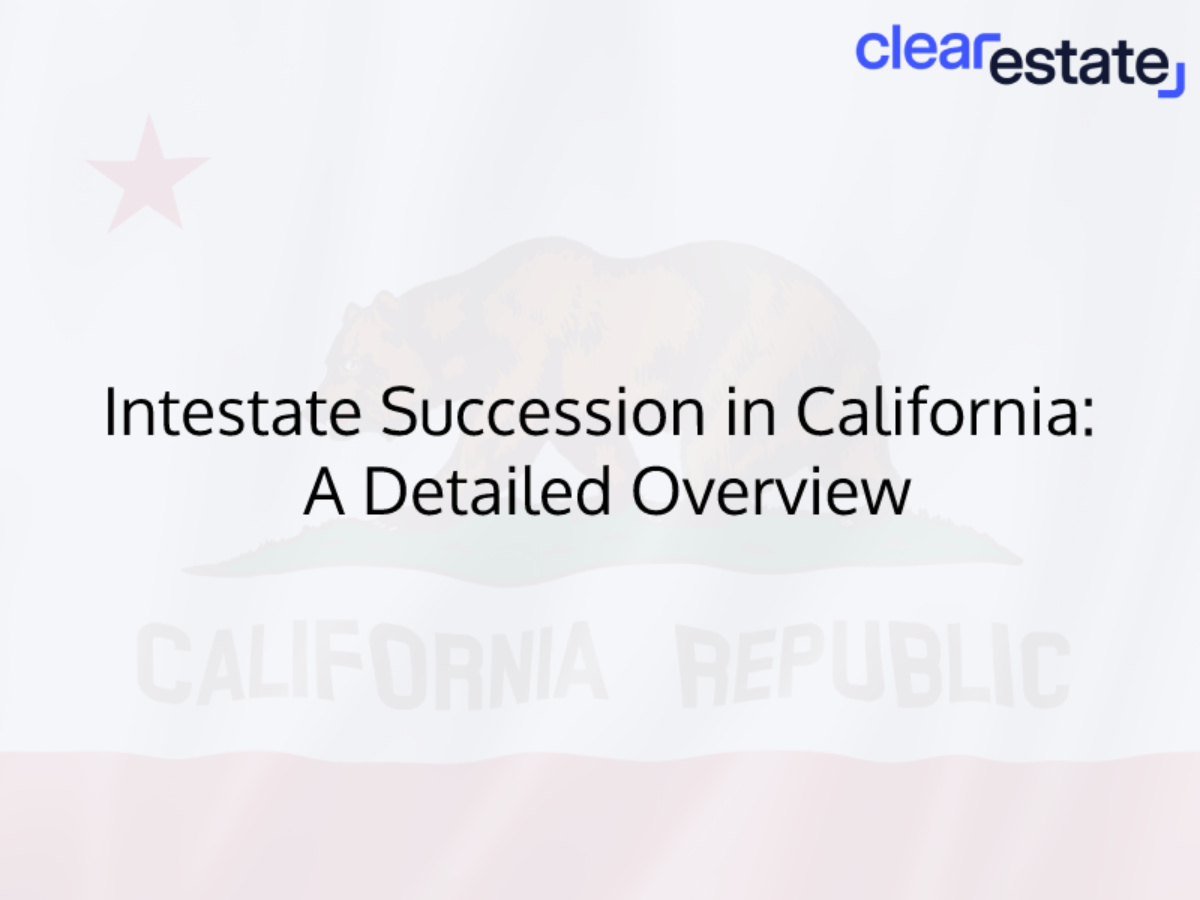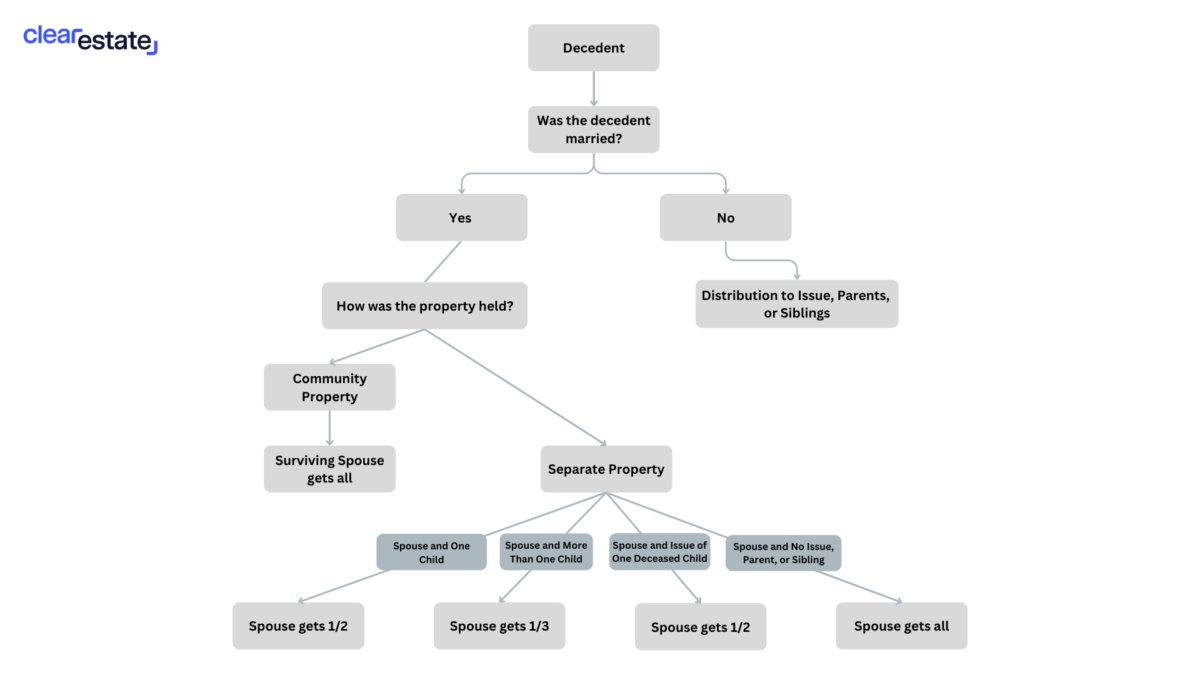Estate Settlement
May 01, 2025
What to Do When Someone Dies in California
Follow this step-by-step guide to navigate legal duties, probate, and estate tasks with clarity and confidence.
A comprehensive guide to intestate succession in California, covering estate distribution, probate, and more.


Article Contents
Any part of a California estate not effectively disposed of by a will passes to heirs under Probate Code §§6400–6455. This means that regardless of what the deceased's wishes were, their estate is distributed according to California's Probate Code. The exact order the estate is distributed depends on a number of factors. Let's begin by reviewing these factors, then look at multiple scenarios to see how California's intestacy laws apply.
In California, the distribution of assets depends on the deceased's marital status, closest relatives, and how property was held.
Here's a simplified breakdown:
For Unmarried Individuals: If the deceased was not married but had adopted or biological children, the children (by representation) equally inherit all assets. If there are no children, but the deceased's parents are alive, they inherit all assets. If there are no surviving parents, the siblings inherit all assets equally. If there are no siblings, the inheritance order is as follows: grandparents, then aunts or uncles, and then cousins.
For Married Individuals or Registered Domestic Partners: In California, registered domestic partners have the same rights as spouses. If the deceased was married or in a registered domestic partnership at the time of death, the distribution of assets is divided into two categories: community property and separate property.
Community Property: Community property is generally property acquired during the marriage/partnership, excluding inheritances and gifts (which are separate). Each spouse/partner owns a 50% interest. At death, the decedent’s 50% of community property passes to the surviving spouse/partner under intestacy. This is commonly confirmed by a Spousal/Domestic Partner Property Petition (a simplified court process) or passes by right of survivorship if title is held that way.
All the separate property if there’s no surviving issue, parent, sibling, or issue of a sibling.
One child, or the issue of one deceased child, or
No issue, but a parent or sibling (or a sibling’s issue) survives.
Two or more children, or
The issue of two or more deceased children, or
One child and the issue of one or more deceased children.
| Deceased’s survivor(s): | Who Inherits: |
| Children but no spouse (or registered domestic partner) | Children inherits everything |
| Spouse (or registered domestic partner) with no children, or no immediate next of kin (parents, siblings, nieces, nephews) | Spouse (or registered domestic partner) inherits everything |
| Sibling with no other next of kin (parents, children, spouse, issue) | Siblings inherit |
| Spouse (or registered domestic partner) and 1 child | Spouse (or registered domestic partner) inherits all community property and ½ (50%) of the deceased’s separate property. |
| Spouse (or registered domestic partner) & 2+ children | Spouse (or registered domestic partner) inherits all community property & ⅓ of deceased's separate property; with children inheriting an evenly split remaining ⅔ of separate property. |
| Spouse (or registered domestic partner) and parents of the deceased | Spouse (or registered domestic partner) inherits all community property, and ½ (50%) of the deceased’s separate property - with the parents inheriting the remaining ½ (50%) of separate property. |
| Spouse (or registered domestic partner) and siblings, no surviving parents | Spouse (or registered domestic partner) inherits all community property, and ½ (50%) of separate property. Siblings inherit the remaining ½ (50%) of separate property. |
To help illustrate the property distribution by California's intestate laws, our professionals at ClearEstate put together a useful California intestate succession chart to help the visual learners understand a bit better:

While intestacy laws dictate the distribution of a deceased person's property when they die without a will, it's important to note that not all assets are subject to intestate laws. Certain types of property are passed directly to named beneficiaries or co-owners, regardless of whether the deceased left a will. Here are some examples:
Living Trusts: Any property that the deceased transferred to a living trust is not subject to intestate succession. Instead, it goes directly to the beneficiary named in the trust document.
Life Insurance Proceeds: The payout from a life insurance policy is not governed by intestate succession. It goes directly to the named beneficiary on the policy.
Retirement Accounts: Funds in retirement accounts, such as an IRA or 401(k), bypass intestate succession. These funds are distributed directly to the named beneficiary on the account.
Transfer-on-Death Accounts: Securities held in a transfer-on-death account, or payable-on-death bank accounts, are not subject to intestate succession. These assets are transferred directly to the named beneficiary upon the account holder's death.
Jointly Owned Property: Property owned with someone else in joint tenancy or as community property with the right of survivorship is not covered by intestate succession. Upon the death of one owner, the property automatically passes to the surviving owner.
The intestate succession process in California deals with how an individual’s estate is distributed when they die without a will, while the probate process is somewhat similar in intestate scenarios there are some differences in-between a regular probate proceeding and an intestate probate case.
Below is a step-by-step format of the intestate succession process in California:
Confirm Intestacy: Confirm that the decedent did not leave a will, or that the will is invalid, meaning that the estate will be subject to intestate succession laws.
Gather Information: Collect information about the decedent’s assets, debts, and potential heirs as per California intestate succession law. This step is crucial to ensure a smooth probate process.
File Petition for Probate: File a petition in the Superior Court of the county where the decedent lived to open a probate case. You need to request an appointment as the administrator of the estate.
Give Notice of Hearing & Publish: Serve the required Notice of Petition to Administer Estate on heirs/required parties before the hearing. Also publish the notice in a newspaper of general circulation.
Hearing & Appointment: Court issues an Order for Probate and Letters of Administration, authorizing you to act.
Notify Creditors: After appointment, mail notice of administration to known or reasonably ascertainable creditors.
Creditor claims are generally due by the later of 4 months after Letters issue, or 60 days after a creditor receives mailed notice.
Inventory & Appraisal: File a court-required Inventory and Appraisal (with probate referee where applicable) within 4 months after Letters issue.
Administer the Estate: Consolidate and safeguard assets; open an estate account. Pay valid debts, expenses, and taxes.
Accounting / Report & Proposed Distribution: File the required accounting or report showing receipts, disbursements, and the proposed intestate distribution.
Court Approval & Distribution: Obtain the court’s order for distribution and distribute assets to heirs under California intestate succession rules.
Close the Estate: File the final accounting/report and petition for discharge. After the court’s final order, complete any remaining transfers and close the estate.
For a full breakdown of early responsibilities and legal steps after a loved one passes, see what to do when someone dies in California.
If the decedent is survived by a spouse or domestic partner, a spousal property petition can be filed. This can help in transferring assets to the surviving spouse or domestic partner without going through the full probate process.
While the laws and regulations we’ve discussed cover common intestate situations in California, there are some uncommon provisions you should make note of. Below is a short summary of less-known but just as important intestacy law provisions under California’s Probate Code
120 Hour Survivorship Period (Probate Law 6403) This law stipulates that for the purpose of intestate succession, a person who doesn't survive the decedent by at least 120 hours is considered to have predeceased the decedent.
Inheritance Rights of Posthumous Relatives (Probate Law 6407) This law states that relatives conceived before but born after the decedent's death inherit as if they had been born during the decedent's lifetime.
Disqualification of Killers from Inheritance (Probate Law 250) This law disqualifies any person who feloniously and intentionally kills the decedent from inheriting any property, interest, or benefit under the decedent's will or trust.
Dealing with the death of a loved one is an already devastating experience, but having to try and understand intestacy laws on top of that is too much. Instead of taking on more burdens, chat with one of our estate professionals to get expert advice when you need it—right now. The best part? Our 30-minute consultation is completely free. Book yours now.
Dying intestate means passing away without a valid will. When this happens, the deceased person's assets are distributed according to intestate succession laws, which vary by state.
When a person dies without a will in California, their estate is distributed according to intestate succession laws. Under California Probate Code, assets typically pass to the closest relatives, starting with the surviving spouse and children. If there is no spouse or children, the estate goes to parents, siblings, and more distant relatives in a specific order. Wondering who inherits when there is no will? Check out our table detailing the Order of Estate Distribution by Intestate Succession Laws in California to see how assets are passed down under state law. To avoid probate complications, estate planning is essential.
According to California's intestate laws - spouses do not automatically inherit all property. This is only the case when the decedent passed away without any surviving relatives, or if all property is owned and held jointly.
In California, probate may not always be required for the surviving spouse. If the deceased spouse estate is composed solely of community property or the assets were held in joint tenancy with another individual, including the surviving spouse, the estate can sidestep the probate court.
Under California Probate Law 6800, any person who passes away intestate and with no living relatives, will have their property escheated by the State of California. This means that the decedent’s property becomes owned by the State. However, this can only happen after a “dormancy period” where the property remains unclaimed for a specific amount of time. For example, savings accounts and life insurance proceeds remain unable to be escheated until they have been inactive for three years.
In the context of someone dying intestate, order of next of kin in California is a legal hierarchy indicating which family members are given priority to inherit the decedent’s estate. Under California’s Probate Code, the order is as follows:
Spouse or Registered Domestic Partner,
Children (biological or adopted),
Parents of the deceased,
Siblings of the deceased,
Nieces & nephews of the deceased,
Grandparents of the deceased,
Aunts, uncles and cousins of the deceased,
Great-grandparents of the deceased,
Stepchildren, where applicable
If there are no next of kin of the decedent alive, then the decedent’s assets become property of the State of California—a process known as escheat.
Yes. California’s Probate Law 6411 states that a person’s nationality or citizenship does not disqualify them from becoming an heir to an estate.
Yes, they are. California Probate Law 6406 ensures that half-blood relatives inherit the same share as they would if they were of the whole blood.
 Simplify Probate Today
Simplify Probate Today
Get expert guidance from our specialists who've helped 10,000+ families.
Book a free consultation